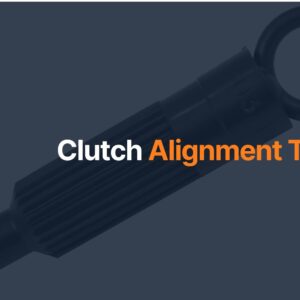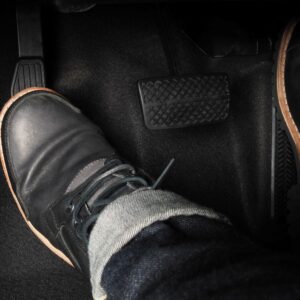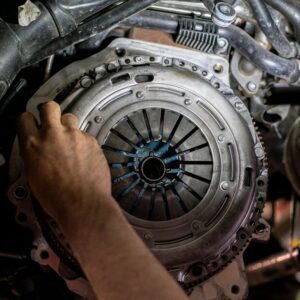Most modern manual transmission vehicles use a hydraulic clutch system.
These systems rely on hydraulic pressure to function, meaning they have hydraulic clutch fluid that you might need to replace if the clutch starts acting up. This clutch fluid is the same as brake fluid and is located in the clutch master cylinder (except on some Ford Escorts, which use the same reservoir for both).
But how do you bleed the clutch properly? Today, we’ll take a look at a few tips and tricks that’ll help you do just that.
Hydraulic Clutches Explained
Hydraulic clutch release systems are commonly used on vehicles since the late 1990s rather than cables or other linkages used on older clutch release systems. Are they better? It depends on who you ask.
Hydraulic clutches operate using a master cylinder and a slave cylinder.
Early hydraulic clutches simply mounted a small slave cylinder on the outside of the clutch housing so that it operated the throwout bearing fork like the older linkage. These are pretty easy to bleed and replace.

Pressing down on the clutch activates the pushrod, which moves a piston in the clutch master cylinder and applies hydraulic pressure to the slave cylinder, which then either directly releases the clutch or operates the clutch release fork and its throwout bearings, forces fluid into the slave cylinder, and triggers a piston that disengages the clutch using a release bearing.
When To Bleed a Clutch
If air gets into a hydraulic clutch system, it can lead to a spongy clutch pedal and a clutch that can’t fully release. You might also notice it’s more difficult to disengage the clutch and you may feel the gears grinding as you try to shift. There’s more resistance when shifting gears. The clutch may engage with the pedal a lot nearer the floor and/or never fully disengage even with the pedal fully depressed.
Tips for Bleeding a Clutch
When it comes down to actually bleeding your vehicle’s clutch, here are a few tips and tricks.
Necessary Items and Preparation
Here are some of the items you’ll want to have on hand when bleeding a clutch:
- A fresh batch of clutch fluid approved by your vehicle’s manufacturer
- A box end wrench
- Clear tubing that can attach to the bleeder valve
- A container to drain the old fluid into
- Safety goggles
- Jack stands
- A hydraulic jack
- Several hours of free time in case it gives you trouble
- A shop manual to tell you the exact steps for bleeding the clutch on your ride
This job is a lot easier with two people, so grab a friend to help. To prepare, jack the vehicle up and put it on jack stands on level concrete. Turn off the ignition, engage the parking brake, and chock the wheels. Once you find the clutch slave cylinder under the hood, remember to clean the area to keep contaminants from falling into the system when you open it for bleeding.
Bleeding the Clutch
You can bleed your vehicle’s clutch through the bleeder valve.
You’ll typically find the bleeder valve on the slave cylinder or near it. It looks like a bolt and has a nipple on one of its ends. When closing the bleeder valve after the bleed, take care not to overtighten, break, or strip it.
By Yourself
Bleeding a clutch by yourself is more difficult and isn’t always as effective. If you have no other choice though, you’ll need to create a vacuum using a hand pump around the bleeder valve. This pump will create pressure for the fluid to flow out.
First, attach the pressure bleeder to the top of the clutch fluid reservoir. Double-check its correct operating range and be sure to stay within that range when you begin pumping the clutch.
Next, rapidly step on the clutch pedal to pump the clutch, creating a vacuum in the clutch system.
Link a clear, flexible hose to the bleeder valve and make sure the other end leads to a sizeable container.
Finally, open the bleeder valve and allow all the fluid and air bubbles to flow through the hose into the container.
The hose should submerge in the liquid as the clutch fluid drains. Once no more bubbles emerge from the submerged hose, you can close the valve and remove the vacuum bleeder.
With Help
If you have help, ask the other person to sit in your vehicle while you watch the bleeder valve.
First, link a clear, flexible tube to your bleeder valve and make sure it leads to a sizeable container.
Then, have the person in your vehicle press the clutch pedal to the floor, holding it down as you slightly open the bleeder valve. Clutch fluid and air should start to drain.
Close the bleeder valve and ask the person in the vehicle to release the clutch pedal.
Repeat this process until you don’t see any more air in the expelled clutch fluid.
Post-Bleed Troubleshooting
After completing the clutch bleeding process, you might notice there are still air bubbles in the clutch fluid. This either means you’ll need a commercial-grade bleeder with a pressure tank or there’s a leak somewhere in the system that’s drawing in air. Either way, it’s best to bring your vehicle to a mechanic so they can diagnose any issues.
Clutch Bleeding Frequently Asked Questions
Here are a few frequently asked questions about bleeding a clutch.
Why Should You Bleed a Clutch?
Bleeding a vehicle’s clutch removes some fluid to get excess air out. This prevents issues like getting stuck in gear or difficult shifting. The air in the system prevents proper hydraulic pressure from building in your vehicle’s hydraulic clutch system, which is what causes these problems in the first place. Bleeding allows you to fully remove the clutch fluid from the system, which also removes the excess air. You can then replace the contaminated fluid with new, purely liquid clutch fluid.
How Often Should You Bleed a Clutch?
Your vehicle’s manual should tell you how often to bleed your clutch. This will typically be every 2 years or 30,000 miles, but it can vary depending on your vehicle’s exact year, make, and model.
You might need to bleed and replace your vehicle’s clutch fluid more often in humid, coastal areas because the fluid is hygroscopic and attracts moisture, and can rust the lines from the inside. Keep an eye on the fluid and check it regularly in case you notice fluid levels dropping. Also watch out for cloudy or milky clutch fluid. That’s a sure sign it’s time for a change.
Should You Drive When Your Vehicle’s Clutch Needs Bleeding?
We don’t recommend driving when your vehicle’s clutch needs bleeding. It can damage your vehicle’s clutch and transmission and cause difficulties shifting. The process isn’t too difficult for a DIY professional, so bleed your vehicle’s clutch or take it to the auto shop as soon as you notice anything amiss.
Where to Get High-Quality Brake Fluid
Bleeding the clutch might seem like a hassle, but it’s better than having to deal with a faulty clutch system. When there’s air in the clutch system, your transmission is likely to malfunction. Trapped air can lead to incomplete clutch disengagement, making it hard to switch gears. This puts you at greater risk of getting into an accident, so it’s best to bleed the clutch regularly. Luckily, getting new brake fluid for your clutch is fast and easy with CarParts.com.
At CarParts.com, you can find a wide selection of brake fluids for your clutch. We’re dedicated to giving you the best products on the market, which is why each product is sourced from only the most trusted manufacturers in the industry. Enjoy high-quality brake fluids at affordable prices. If you find a competitor selling the same product for cheaper, let us know, and we’ll beat or match their price on the spot.
Don’t wait until your vehicle’s hydraulic clutch system starts acting up before bleeding the clutch. Check out our catalog of high-quality brake fluids at CarParts.com and get one for your vehicle today!
Any information provided on this Website is for informational purposes only and is not intended to replace consultation with a professional mechanic. The accuracy and timeliness of the information may change from the time of publication.

































